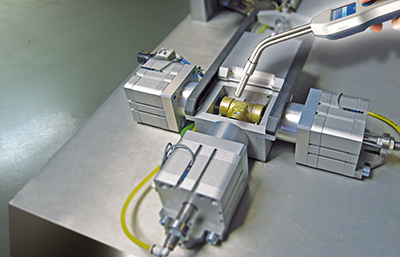Testing the Testers – Reducing Downtime on the Production Line

Different designs of test fixtures are used to hold the test objects in place and create optimized conditions for leak detection.
Products designed to be leak-proof need testing during or after manufacture to ensure tightness. However, the test equipment used to check for leaks, with pressure difference or tracer gas, also needs to be free from leaks. Otherwise, perfectly good products will fail the leak test only because of worn out or leaking test equipment.
Many types of vessels, pipes, tubes and other components have to be leak-free when leaving the manufacturer. A common method for testing this is to use some type of pressure difference testing equipment, or tracer gas equipment.
The parts are tested in a leak testing fixture. Each part is tested individually, so the process needs to be quick and efficient. The product is held in place and all its openings are sealed. A traditional testing method is to inject air through openings in the fixture and a pressure sensor measures the pressure. If pressure decays over time, the product is considered leaking and if it remains within pre-set limits, it is considered good.
However, over time the seals of the fixture will start to deteriorate. A leaking fixture will cause the same symptoms as a leaking product and the leakage will, in all likelihood, be diagnosed as product failure, at least initially. The rate of test failures will increase over time, with products that would have been within allowable limits now being failed. Finally, when many more products are failed than would reasonably be expected, the staff usually begins to suspect that the fixture is leaking.
Locate Leaks on the Faulty Fixture
At this point, there are two traditional methods to locate the fault. The first one is to replace the seals one by one until the leakage stops. This method is time consuming. The other method is to apply soapy water to the fixture to see where bubbles emerge. This method is inaccurate and small leaks may still persist after the repair. While the fixture gets a bit better, it is still underperforming.
However, a third method is to fill the system with tracer gas and detect any gas escaping. Even the smallest leaks can easily be detected using a leak detector. The test is so quick and easy to perform that it can be part of the daily maintenance routine, avoiding the scenario with failing perfectly good products. Only the seals that actually leak are replaced, avoiding unnecessary work.
In industries with high demands on continuous production, this will also prevent unscheduled downtime while the fixture is examined for leaks. When using accurate gas leak testing as part of preventive maintenance, fixture leakage becomes a thing of the past.
Benefits of Leak Testing Fixtures with Tracer Gas
- Avoids failing perfectly good products
- Avoids unnecessary work by replacing only the seals that are leaking
- Test result independent of operator evaluation
- Able to detect even the smallest leaks
For further details on how detect leaks in fixtures, please contact us at reachus@inficon.com.